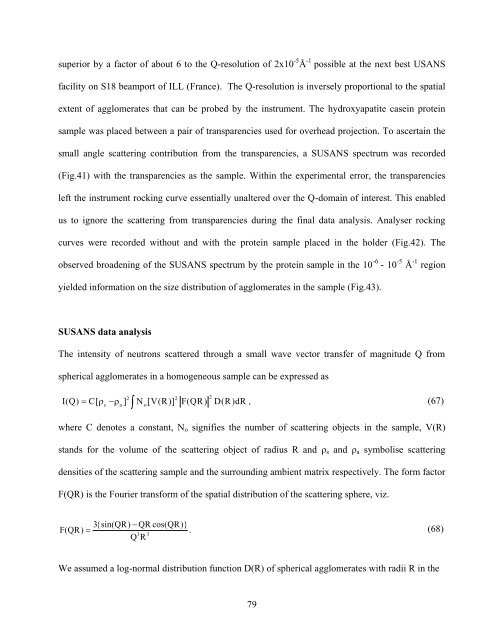PHYS01200804001 Sohrab Abbas - Homi Bhabha National Institute
PHYS01200804001 Sohrab Abbas - Homi Bhabha National Institute
PHYS01200804001 Sohrab Abbas - Homi Bhabha National Institute
You also want an ePaper? Increase the reach of your titles
YUMPU automatically turns print PDFs into web optimized ePapers that Google loves.
superior by a factor of about 6 to the Q-resolution of 2x10 -5 Å -1 possible at the next best USANS<br />
facility on S18 beamport of ILL (France). The Q-resolution is inversely proportional to the spatial<br />
extent of agglomerates that can be probed by the instrument. The hydroxyapatite casein protein<br />
sample was placed between a pair of transparencies used for overhead projection. To ascertain the<br />
small angle scattering contribution from the transparencies, a SUSANS spectrum was recorded<br />
(Fig.41) with the transparencies as the sample. Within the experimental error, the transparencies<br />
left the instrument rocking curve essentially unaltered over the Q-domain of interest. This enabled<br />
us to ignore the scattering from transparencies during the final data analysis. Analyser rocking<br />
curves were recorded without and with the protein sample placed in the holder (Fig.42). The<br />
observed broadening of the SUSANS spectrum by the protein sample in the 10 -6 - 10 -5 Å -1 region<br />
yielded information on the size distribution of agglomerates in the sample (Fig.43).<br />
SUSANS data analysis<br />
The intensity of neutrons scattered through a small wave vector transfer of magnitude Q from<br />
spherical agglomerates in a homogeneous sample can be expressed as<br />
2 2<br />
2<br />
s a (67)<br />
o<br />
I(Q) C[ ] N [V(R)] F(QR) D(R)dR ,<br />
where C denotes a constant, N o signifies the number of scattering objects in the sample, V(R)<br />
stands for the volume of the scattering object of radius R and ρ s and ρ a symbolise scattering<br />
densities of the scattering sample and the surrounding ambient matrix respectively. The form factor<br />
F(QR) is the Fourier transform of the spatial distribution of the scattering sphere, viz.<br />
3{sin(QR) QR cos(QR)}<br />
F(QR) .<br />
(68)<br />
3 3<br />
Q R<br />
We assumed a log-normal distribution function D(R) of spherical agglomerates with radii R in the<br />
79
















